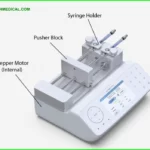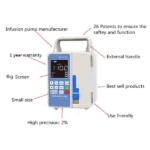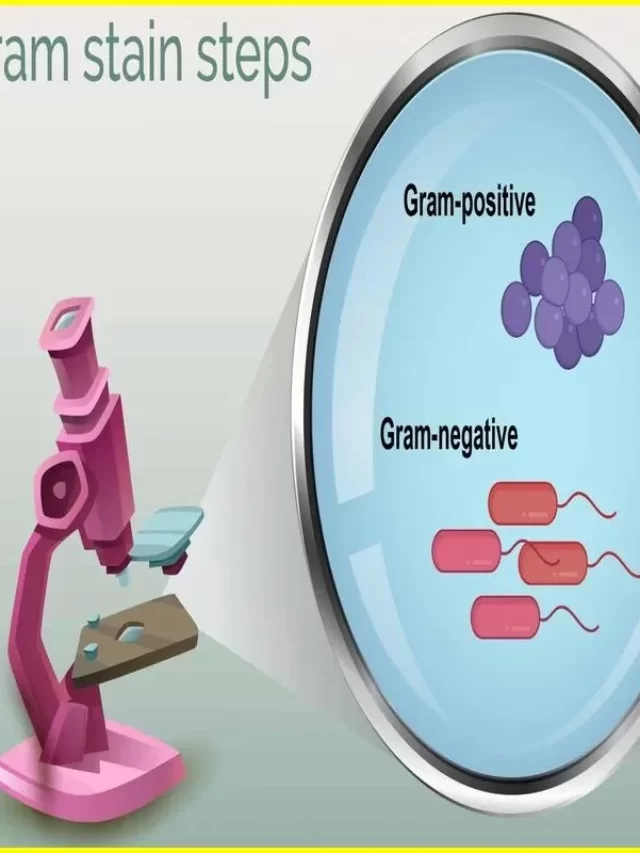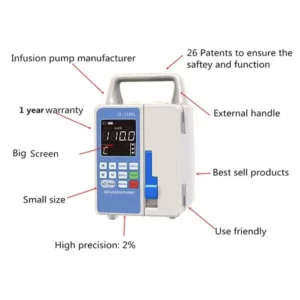
What is infusion pump
Infusion pumps large or small volumes of liquids at high flow rates are able to be delivered to the patient, and are used to deliver nutrients or drugs. Such as insulin or other hormones, antibiotics, chemotherapy drugs, and pain relievers etc. are given through this device.
Article About:- Health & fitness
Article About:- Medical Technology
Article About:– Sports
Medications need to go through proper rate and volume so we use infusion pump.
Infusion Pump is a medical device that delivers fluids such as nutrients & medications, into patient’s body in controlled amount.Infusion is one way to treat or manage neurological conditions/disorder of nervous system. An infusion pumps draws fluid from a standard bag of intravenous fluid & controls the rate of flow.It provides continuous & accurate therapy. Thse devices often have enough power to pump fluids, fluid is pumped through tiny catherters into patient’s blood vessels. 1280
There are types of infusion from technician/nurse that sets them up: –
1. Continuous Infusion: – This has small pulses of infusion between 500 nanolitres & 10millilitres, depending on pump’s design.
2. Intermittent Infusion: – This has high infusion, alternating with low infusion rate to keep cannula open.
3. Patient-Controlled Infusion: – This avoids intoxication & rate is controlled by pressure pad/button that can be activated by patient.
4. Total Parental Nutrition: -This has an infusion curve similar to normal mealtimes. As the Infusion pumps have many benefits some of the disadvantages.
5. Software defects
6. User interface issues
7. Mechanical/electrical failure
Infusion Pump How it Works
An infusion pump is a medical device designed to deliver fluids, medications, or nutrients into a patient’s body in a controlled and precise manner. Here’s a general overview of how an infusion pump works:
Programming: The healthcare provider or nurse programs the pump with the necessary settings, including infusion rate, VTBI (Volume to Be Infused), and any other specific parameters based on the patient’s condition and the prescribed treatment.
Tubing and syringe/bag connection: The infusion pump is connected to the patient’s intravenous (IV) line through a tubing system. The tubing may be attached to either a syringe containing the medicine or to a bag of fluid.
Flow Rate Control: The pump controls the flow rate of the fluid according to the programmed settings. It uses a motor-driven mechanism or a pressure-driven system to precisely control the rate of infusion. Some pumps may also have built-in sensors to detect pressure changes or blockages in the tubing.
Monitoring: The infusion pump continuously monitors various parameters during the infusion process. This can include monitoring the flown volume, flow rate, air bubbles in the tubing, occlusion and alarming for any deviations or issues.
Alarm and Safety Features: Infusion pumps are equipped with safety features and alarms to ensure patient safety. These alarms can alert healthcare providers if there is a blockage, air in the tubing, low battery, completion of the infusion, or any other potential problem.
Data Recording: Some modern infusion pumps have the ability to record and store data related to the infusion process, including date, time, flow rate, and volume delivered. This data can be used for documentation, analysis and patient monitoring purposes.
It is important for healthcare professionals to regularly inspect and maintain infusion pumps, follow proper protocols for drug preparation and administration, and ensure that the infusion site is properly monitored. This helps reduce the risk of errors and ensures the safe and effective delivery of fluids and medications to patients.
what is the Infusion pump advantage and disadvantage
| Advantage | Disadvantage |
| The volume of syringe used limits the fluid dispensing volume. | administering drugs intravenously |
| Excessive resistance may lead to the build-up of pressure and eventual failure of the syringe pump. | This injects a needle directly into the patient’s arm. |
| The flow rate during the transient period cannot be known without flow sensors. | This allows for more efficient treatment of chronic diseases. |
| It delivers medication, antibiotics and/or hydration directly into the bloodstream. |
Syringe Pump Vs Infusion Pump
Syringe pumps and infusion pumps are both types of medical devices used for the controlled delivery of liquids and drugs, but differ in their mechanism of operation and intended use. Here is a comparison between syringe pump and infusion pump:
Syringe Pump:
- Operation: A syringe pump uses a motorized mechanism to push the plunger of a syringe, allowing precise and controlled delivery of medication or liquids.
- Syringe Compatibility: Syringe pumps are designed to work with syringes of different sizes, allowing for the flexibility or ease of delivering small amounts of medication.
- Applications: Syringe pumps are commonly used in situations where precise, low-volume infusions are required, such as in critical care units, anesthesia, and neonatal care. They are suitable for delivering drugs that require high precision, such as potent drugs or drugs with a narrow therapeutic range.
- Flow rate control: Syringe pumps allow highly precise flow rate control, usually measured in milliliters per hour (mL/h) or milliliters per minute (mL/min).
- Advantages: Syringe pumps provide precise delivery of small volumes, high accuracy and the ability to control flow rates at very low rates.
Infusion Pump:
- Operation: Infusion pumps use a variety of mechanisms, such as peristaltic pumps or pressure-driven systems, to control and deliver liquids or drugs.
- Fluid container compatibility: Infusion pumps are typically designed to work with larger fluid containers, such as bags or bottles, rather than syringes.
- Applications: Infusion pumps are used for a wide range of applications in hospitals, clinics, and homecare settings. They are suitable for delivering large amounts of fluids or medicines over an extended period of time. Infusion pumps are commonly used for IV fluids, parenteral nutrition, blood transfusions, and continuous drug infusions.
- Flow rate control: Infusion pumps offer a wide range of flow rate control, usually measured in milliliters per hour (mL/h).
- Benefits: Infusion pumps are versatile, allowing the delivery of large volumes over long periods of time. They are often equipped with additional safety features, such as alarms, occlusion detection, and air bubble detection.
It is worth noting that the terms “syringe pump” and “infusion pump” are sometimes used interchangeably or as an overlap, and there are hybrid devices that combine syringe pump and syringe pump, depending on configuration and settings. Infusyon pumps can act as both. The choice between a syringe pump and an infusion pump depends on the specific clinical needs, the volume and accuracy required, and the type of fluid or drug being administered.
Continuous Infusion
Its continuous infusion may provide the advantage of maintaining therapeutic levels of the diuretic over a more extended period than bolus administration. Lipophilic opioids are usually administered to the patient as continuous epidural infusions because their rapid onset and short duration facilitate analgesic titration. Epidural fentanyl mixed with a dilute solution of bupivacaine may produce better analgesic results.
Article About:- Health & fitness
Article About:- Medical Technology
Article About:– Sports
Intermittent Infusion
This intermittent infusion is the best device that is maintained at a moderately slow infusion rate as it minimizes the risk of fluid overload and electrolyte imbalance.
Patient-Controlled Infusion
A computerized pump attached to the IV allows the patient to release pain medication by pressing an automatic handheld button. It is used to reduce pain after surgery. Or it can be used for painful conditions such as pancreatitis or sickle cell disease. It also works well for people who cannot take medicines by mouth. 
Total Parental Nutrition
Total parenteral nutrition (TPN), also known as parenteral nutrition (PN), is a form of nutritional support given entirely through the bloodstream with an IV pump. It manages the proteins, carbohydrates, fats, vitamins and minerals in the patient’s body. The main three macronutrients are
a. lipids emulsions
b. proteins
c. dextrose
FAQ
What is vtbi in infusion pump

VTBI stands for Volume To Be Infused. In the context of an infusion pump, VTBI refers to a predetermined amount of fluid or medication that is programmed to be infused into the patient’s bloodstream. This represents the total volume of solution that the pump will deliver during the infusion.
What is an iv infusion pump

An IV infusion pump is a medical device used to deliver fluids, medications, or nutrients directly into a patient’s bloodstream through an intravenous (IV) line. It is designed to provide precise control over the flow rate and volume of the infused substances. IV infusyon pumps are widely used in healthcare settings, including hospitals, clinics, and homecare, to ensure accurate and controlled administration of fluids and medications.
Flow Rate Control.
Volume to Be Infused (VTBI).
Programmable Settings.
Alarms and Safety Features.
Multiple Infusion Modes.
How does an infusion pump work

An infusion pump works by precisely controlling the flow rate and volume of fluids or medications being delivered to a patient’s bloodstream.
Programming.
Tubing and Connection.
How to calculate infusion pump rate

To calculate the infusion pump rate, you need to know the desired infusion duration and the volume to be infused (VTBI). The formula to calculate the infusion pump rate is as follows:
Infusion Pump Rate (mL/h) = VTBI (mL) / Infusion Duration (hours)
Determine the VTBI
Apply the formula.












